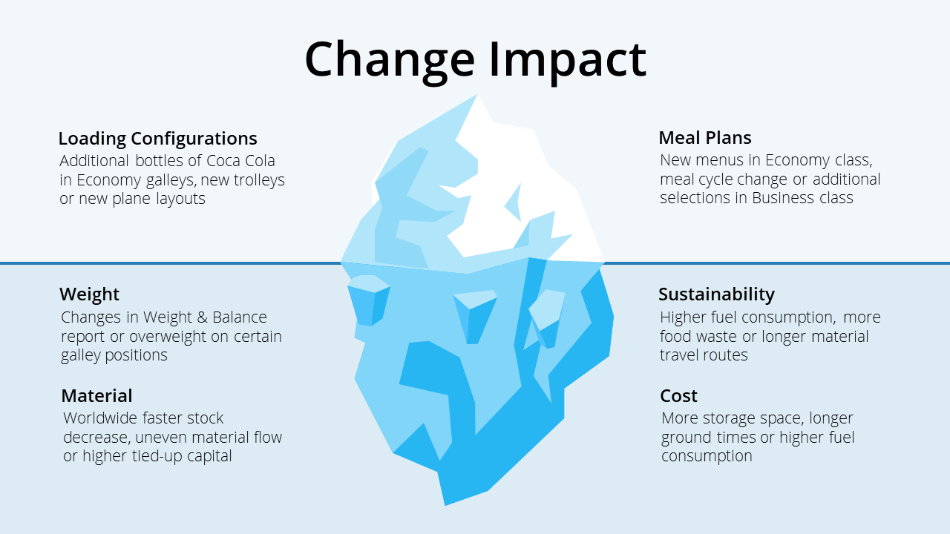Continuous Improvement and Inflight Logistics
LimeFlight's ability to jump back and forward in time allows airlines to plan for tomorrow

With LimeFlight's versioning, airlines can identify the impact of changes to their operations, inform all affected parties, evaluate, and adjust promptly.
Aviation is by no means a static industry. On the contrary, change is an inevitable facet of every aspect of the industry, not least inflight services. Seasonal flight plans, destination changes, altered departure schedules, supplier changes, new routes, aircraft adjustments and much more will influence inflight services, with even a slight change altering the entire logistics process.
Whether temporary or long-term, any change to inflight operations impacts the entire supply chain, and the consequences are not always visible from the outset. Therefore, a core element of the LimeFlight application is to intuitively implement and seamlessly communicate the planning, modification, and evaluation of changes to inflight services - we call this versioning.
When is a new version needed?
Airlines are familiar with the need to adjust one or more of their load plans due to crew feedback, rebranding or new regulations. An example of this is when the crew report that there are always at least two Cola bottles left unused on every short-haul flight, while there is not a sufficient amount of Diet Cola. Consequently, the airline would like to address the imbalance to ensure that all customers receive their desired beverage and at the same time reduce any unnecessary drinks being transported.
Step One – Create a draft version
The first step in the versioning process is to implement the change for a future date in a draft form. The time between the creation of the draft and the active date depends on the scope of the modification.
The draft may be set just a couple of days or weeks in advance for a minor alteration, like removing two Cola bottles and adding three Diet Colas to each short-haul flight. By altering the loading catalogues used for the airline's short-haul flights, the airline can change the amount of Cola carried on all departures using this configuration.
Step Two – Review
Once the draft is created, the parties affected are notified and can review the changes. This notification process has the advantage that all participants are informed of the alteration in good time and can adjust their operations accordingly. For example, the airline would inform the caterers if a loading plan were altered due to an adjustment in the Cola stock amounts.
Step Three – Revision
Once the change enters the revision phase, the parties can review, amend, or inform the airline of any conflicts. In addition, this phase allows the parties to assess whether the change is possible.
In this circumstance, the caterer sees that they are to reduce the short-haul trolleys by two Cola bottles and add three Diet Colas. If they assess this as possible, the caterer can accept the change; if not, they can provide a reason, e.g., they need more time to source the Diet Cola.
In the revision phase, a loop is built into the methodology to avoid one party changing a version after others have reviewed it. For this reason, after each alteration by a stakeholder, the version goes back to the review phase. Here, the person responsible can again inform all parties of the change. This cycle continues until no more changes are made. This loop avoids a break in communication and ensures that all parties are informed of the final status.
If no alterations are made to a revision, the new version remains inactive until the activation date. In other words, caterers continue to pack the trolleys with the usual Cola amounts until the new versions start date.
Step Four – Active
When the active date is reached, the change becomes the system's current state, and the previous version is archived. Hence, this means that caterers are now required to load trolleys with two fewer bottles of Cola and additional bottles of Diet Cola for all short-haul flights.
Step Five – Archived
As soon as a new version replaces the previous, the last version is archived. Or, in this case, the information that all short-haul flights had stocked ten cola bottles on their trolleys rather than eight is archived and remains visible for future analysis.

The impact of versioning
Versioning offers airlines three key benefits ensuring that changes can be made quickly and efficiently, while ensuring a smooth transition from previous to the new operations.
First, the process means that all parties can be informed of changes promptly, adjust their operations, and ensure a seamless transition to new configurations.
Secondly, the changes do not have to take effect to be helpful. The versioning process allows the impact of what-if scenarios to be understood. Scenario planning means that airlines can create new versions in draft form across all LimeFlight modules and analyze the effect of any changes. In other words, the airline can see the impact of changes without altering the current state and data in the system, providing a risk-free means of planning.
Finally, past changes are a record of previous operations of the airline, the alterations made and their consequences. In this sense, the archive serves as a history book and provides insights into the past for better future planning.
The final word
Any change to the inflight service causes ripples that spread beyond an airline and the present time.
On the one hand, parties involved in preparing, stocking, and delivering the inflight services are affected by changes. They may need to recruit and train new staff or retrain existing staff, produce, and publish more assembly instructions or order new materials. On the other hand, an airline may not capture the long-term impact of changes to its operations without proper scenario planning and historical data to support it.
Versioning can speed up this process and ensure that changes are well thought out, analyzed, and implemented without significant deviations from the usual process so that inflight services can continue without impacting the customer experience.




